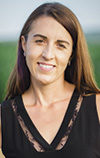I’ve done numerous speaking engagements throughout the years, but nothing comes close to the impact of an actual on-farm tour. I live for the “lightbulb” moment – when what I am explaining suddenly makes sense, when a consumer can relate in a way they never thought they could to dairy farming. You can see this moment on their face. This moment makes the time I carve out of my busy schedule totally worthwhile.
Before touring a farm, people don’t realize all the questions they really have and how much they will learn by being able to see, smell and touch things in person – live, in real time. This is when they form opinions on their own and not because they read 50 comments beforehand on a social media post. So if we can’t get everyone on an actual farm, allowing them to at least see one, with an actual farmer leading the way, is the next best thing.
Getting ready
When Emma Andrew-Swarthout from our local dairy checkoff, American Dairy Association North East, called and asked me if I’d be willing to host a live virtual farm tour, I didn’t even have to think about it. Emma poured her heart and a lot of time, effort (and probably blood, sweat and tears) into launching this new project.
Smartly, she created two: one for elementary-aged kids and one for middle- and high-school students. Knowing me well, she asked if I’d be willing to film for the latter, as I’ve had past and current teaching experience with this age group.
After going over a rough outline on what we wanted to cover, Emma ran a WiFi test on the farm the week before the tour to ensure we had strong internet access. A day before the event, we did a run-through with the film crew (which was only two people) to practice what I would say, what shots we should get, timing, etc. Teachers and students who signed up for the tour could pre-submit questions, so we reviewed those, making sure my talking points were on point.
The big day
I was outfitted with a headset that made me feel like an NFL broadcaster (which was pretty cool). Emma was stationed in our farm office as she expertly emceed the tour with a welcome to the students and teachers tuning in. Because cute Jersey calves always captivate people (this is always the last stop on an in-person tour because I can never get people out of our calf barn), we started with them, then ventured to the hospital pen, milking parlor, milkhouse and the freestall barn.
All throughout the tour, attendees were able to submit questions in real time, which Emma would read to me and I was able to answer on the spot. This was great because I could answer these questions as they related to where we currently were in the tour. My favorite part was the Q&A session at the end, which I made sure I allowed plenty of time for. People have great questions. And I was so happy to answer them and explain why we do what we do. Some of the questions I received were:
- “Are farmers really as financially unstable as the media reports?”
- “How natural is it if it comes from genetically modified organisms?”
- “How is our food safety ensured?”
- “What chemicals or pesticides are used?”
- “Has farming become harder or easier with technological advances?”
To see and hear how I answered these, plus more, check out the recorded tour or search YouTube for “American Dairy Association North East” to find the link.
The tour was a total of 45 minutes, which is the average class time in most schools. I had to give a hybrid version of what I normally do, but I was still able to educate and engage with those who, without a program like this, would have never had the opportunity to see a real farm and talk to a real live farmer. For those who couldn’t attend the live session, the tour was recorded and put on YouTube so anyone could watch it at their convenience.
Tuning into this virtual farm tour were 38 middle and high schools, 16 school districts and a total of over 470 students. Four out of five teachers said they would recommend the experience to fellow educators. Due to the success of this tour and the elementary tour given by Emma’s father at their dairy in New York, there are three more opportunities in March for schools and students to attend another live farm experience. Check out American Dairy Association North East - virtual farm tour.
To my fellow dairy farmers, please don’t pass up opportunities like this. Share with people what we do. Be part of the education movement that is now in agriculture and won’t be going away any time soon. Being involved with this program is not only rewarding to those tuning in but also to you, knowing that now there are more people out there who have a better understanding about dairy than they did before. Give them a chance to “ask a farmer, not Google.” ![]()

-
Katie Dotterer-Pyle
- Dairy Producer
- Union Bridge, Maryland
- Email Katie Dotterer-Pyle




